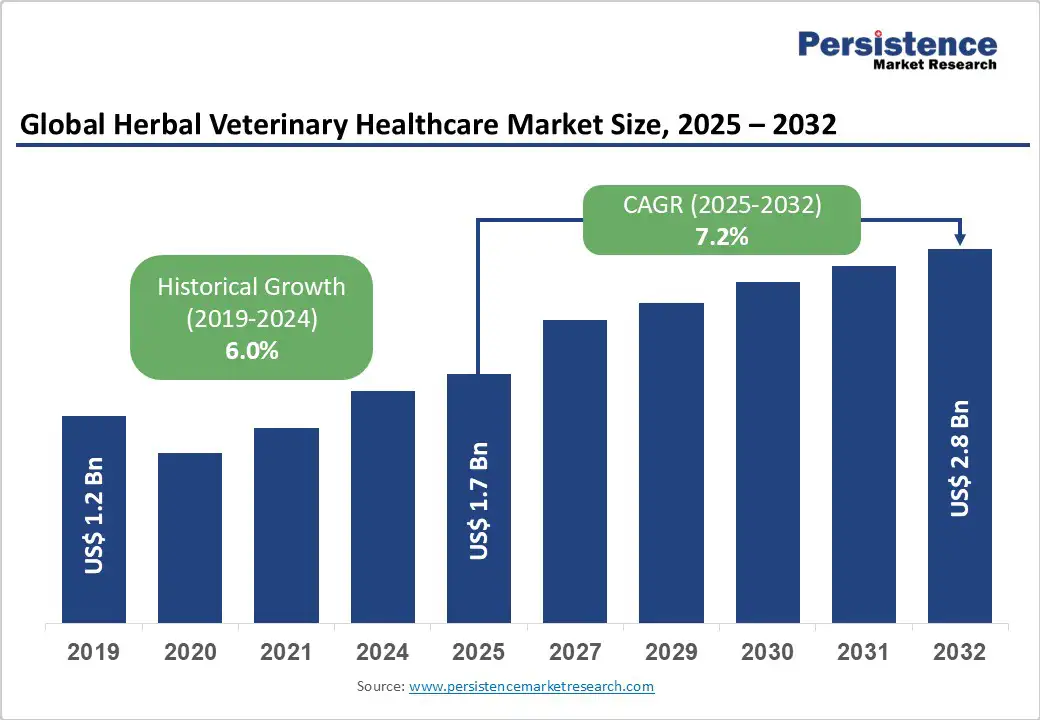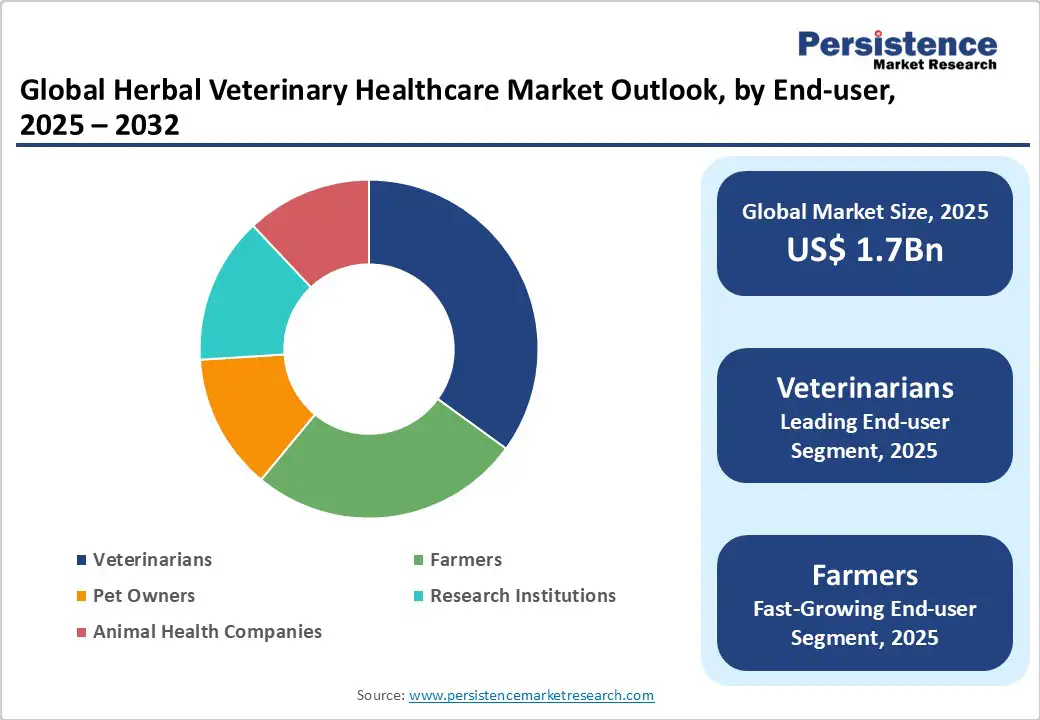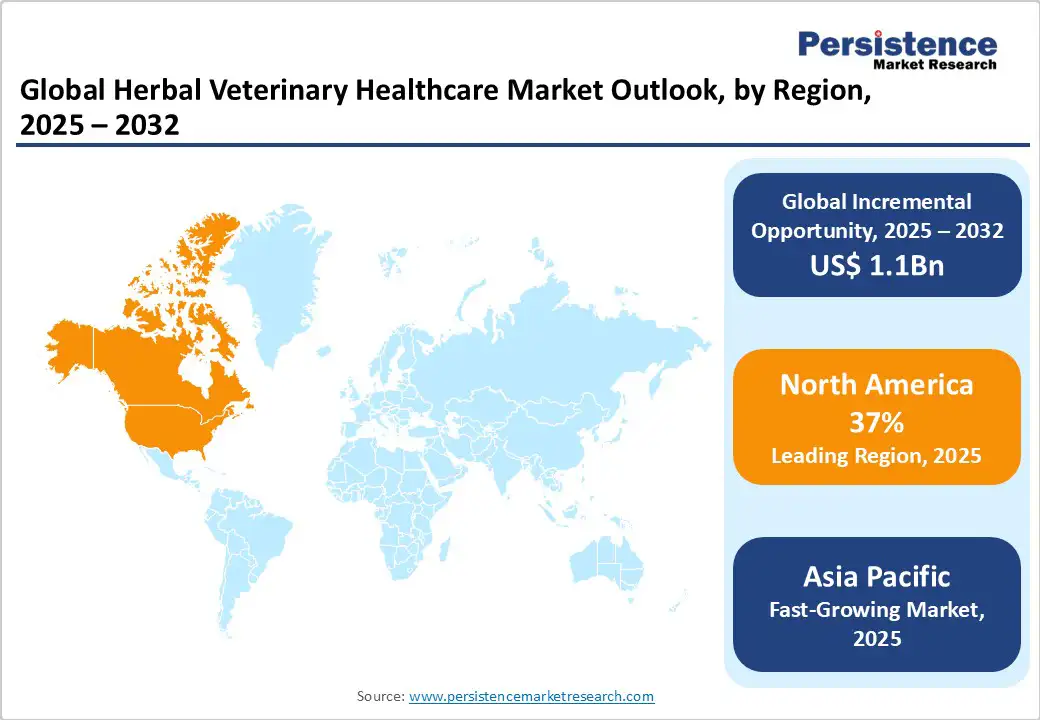ID: PMRREP22825| 196 Pages | 15 Oct 2025 | Format: PDF, Excel, PPT* | Healthcare

The global herbal veterinary healthcare market size is likely to be valued at US$1.7 Bn in 2025 and expected to reach US$2.8 Bn by 2032, registering a robust CAGR of 7.2% during the forecast period from 2025 to 2032, fueled by the increasing demand for natural and organic animal health solutions, advancements in herbal formulations, and a global push toward sustainable veterinary practices and animal welfare.
The industry’s expansion is further supported by efforts to reduce reliance on synthetic drugs, foster eco-friendly treatments, and improve health outcomes for livestock and companion animals, particularly in North America, which leads the industry.
| Key Insights | Details |
|---|---|
|
Herbal Veterinary Healthcare Market Size (2025E) |
US$1.7 Bn |
|
Market Value Forecast (2032F) |
US$2.8 Bn |
|
Projected Growth (CAGR 2025 to 2032) |
7.2% |
|
Historical Market Growth (CAGR 2019 to 2024) |
6.0% |

The global surge in demand for natural and organic animal health solutions is a primary driver of the herbal veterinary healthcare market. According to the 2025 APPA National Pet Owners Survey, as cited in APPA's 2025 State of the Industry Report, 94 million U.S. households own a pet. This alarming prevalence is exacerbated by an increasing data consumption rate, with global organic livestock production expected to grow rapidly in the coming years, and rising lifestyle-related digital dependencies, as sustainable networks become a leading global connectivity burden. In response, governments and veterinary operators are investing heavily in herbal infrastructure, with the United States leading in the adoption of herbal remedies for pet densification to support end-stage urban coverage gaps. In Europe, where organic rollout cases are steadily increasing, initiatives such as the EU's Farm to Fork program highlight the growing focus on spectrum-efficient wireless treatments.
Furthermore, the livestock sector, which accounts for a substantial portion of global animal health expenditures, is increasingly relying on herbal veterinary healthcare to mitigate the impacts of antibiotic resistance in regions with limited fiber resources. The burden of data-intensive applications is projected to increase significantly in terms of prevalence, latency requirements, and quality-of-service metrics over the coming decades.
In the Asia Pacific, young demographics are also increasingly affected, driving demand for reliable solutions such as oral herbal tonics and topical salves. Growing investments in research focused on ethnobotanical veterinary challenges further boost the industry by promoting advanced herbal formulations. Overall, these factors are expected to sustain market growth, with emerging economies leading the adoption through public-private partnerships and technology transfers.
The high costs associated with sourcing, extracting, and standardizing herbal ingredients remain a major restraint for the herbal veterinary healthcare market. Obtaining rare botanicals from sustainable farms requires significant investment in cultivation, harvesting, and quality assurance, often driving up overall expenses. Additionally, regulatory compliance with authorities such as the FDA and EMA demands rigorous efficacy and safety trials, which extend development timelines and place a heavy burden on smaller companies with limited resources. Another challenge is the inconsistency in herbal potency caused by seasonal and geographical variations, which makes it difficult to achieve standardized formulations.
This inconsistency hampers large-scale production and limits the ability to deliver uniform therapeutic outcomes. In developing markets, where cost sensitivity is high, these factors collectively hinder adoption and restrict accessibility. As a result, despite growing demand for natural alternatives, these financial and regulatory hurdles remain significant barriers to the widespread adoption of natural products in the market.
The emergence of nanotechnology in herbal delivery systems and the rapid expansion of e-commerce platforms present significant opportunities for the herbal veterinary healthcare market. Nanotechnology allows the encapsulation of herbal extracts into advanced delivery systems, enhancing their bioavailability and ensuring more effective absorption in animals. This innovation enables the development of premium, targeted therapies that address chronic conditions with improved precision and efficiency compared to conventional formulations. By overcoming challenges such as poor solubility and variable potency, nano-based delivery systems elevate the credibility of herbal treatments within the veterinary community and expand their acceptance in mainstream animal healthcare practices.
At the same time, the growth of online veterinary marketplaces is reshaping distribution channels for herbal veterinary products. These digital platforms enable direct-to-consumer sales, improving accessibility for pet owners and livestock farmers, particularly in underserved or rural areas where veterinary services may be limited. Subscription-based models and personalized product recommendations offered through e-commerce platforms also encourage repeat purchases, enhancing customer loyalty and driving steady demand.
The combination of advanced nanotechnology-driven formulations with accessible digital sales channels positions the industry for strong expansion, opening new revenue streams while meeting the growing global preference for natural and effective veterinary solutions.
The herbal veterinary healthcare market is segmented into oral, topical, and others. Oral dominates, holding approximately 45% share in 2025, due to its proven efficacy in systemic delivery, ease of dosing, and integration into standard feeding protocols. Oral herbal supplements are widely used in preventive care for livestock and pets, offering broad therapeutic coverage with minimal stress.
Topical is the fastest-growing segment, driven by increasing demand for localized applications in skin and wound management. Topical formulations offer targeted action as non-systemic options, with advancements in transdermal enhancers and natural preservatives making them particularly suitable for sensitive dermatological conditions.
The herbal veterinary healthcare market is segmented into allergies, arthritis, difficult dermatology cases, gastrointestinal disease, and others. Allergies dominate, holding approximately 30% share in 2025, due to their proven efficacy in immune support, anti-histamine properties, and integration into seasonal care regimens. Allergy treatments are widely used in companion animals, offering relief that minimizes steroid dependency.
Arthritis is the fastest-growing segment, driven by increasing demand for joint mobility aids in aging pets and working animals. Arthritis herbal therapies provide anti-inflammatory benefits as natural adjuncts, with advancements in curcumin-based complexes making them suitable for chronic pain management.
The herbal veterinary healthcare market is segmented into veterinarians, pet owners, farmers, research institutions, and animal health companies. Veterinarians hold approximately 55% of the market share in 2025, due to their role in professional validation, customized regimens, and integration into clinical workflows. Veterinarians drive adoption through evidence-based recommendations for holistic protocols.
Farmers are the fastest-growing end-user, driven by increasing demand for cost-effective herd health solutions in intensive agriculture. Farmers utilize bulk herbal feeds as preventive measures, with advancements in probiotic-herbal blends making them suitable for large-scale gastrointestinal support.

North America dominates the global herbal veterinary healthcare market, expected to account for 35% share in 2025, supported by a well-established veterinary ecosystem, strong infrastructure investments, and a cultural shift toward natural wellness and pet humanization. The United States serves as the primary growth hub, benefiting from rising consumer demand for organic and clean-label pet products alongside increasing awareness of antibiotic resistance. Government support for sustainable farming practices and veterinary innovation has further encouraged the adoption of herbal-based treatments.
Regulatory approvals from agencies such as the FDA also enhance product credibility, enabling wider integration of herbal therapies into mainstream veterinary care. In addition, the rapid adoption of telemedicine platforms has improved access to veterinary consultation for rural farmers and pet owners, broadening market reach. Together, these factors reinforce North America’s leadership, positioning the region as a key driver of innovation and adoption in the herbal veterinary healthcare landscape.
Europe represents a significant share of the global herbal veterinary healthcare market, driven by stringent eco-regulations, a strong heritage of herbal medicine, and growing consumer preference for sustainable animal care solutions. Countries such as Germany and the United Kingdom lead regional adoption. Germany, with its deep research focus on phytotherapy, is at the forefront of developing advanced herbal formulations, particularly for gastrointestinal treatments in livestock, where demand for natural alternatives to antibiotics continues to rise.
The United Kingdom plays a critical role through regulatory initiatives led by the Veterinary Medicines Directorate, which has streamlined approval processes for herbal veterinary products, accelerating the availability of solutions for conditions such as pet allergies and skin sensitivities. Broader cultural acceptance of natural medicine, combined with government-backed initiatives to promote eco-friendly farming practices, has further strengthened the industry. This alignment of tradition, innovation, and regulatory support ensures Europe’s strong position in driving herbal veterinary healthcare adoption.
Asia Pacific is the fastest-growing region in the global herbal veterinary healthcare market, driven by its agrarian economies, expanding urban centers, and a deep-rooted tradition of herbal medicine. China and India are at the forefront of this growth. In China, government programs promoting organic agriculture are increasing demand for herbal-based supplements in poultry and livestock farming, reflecting a nationwide push toward sustainable animal care.
In India, AYUSH-led initiatives continue to support the development of advanced herbal formulations, particularly for conditions such as joint and mobility issues in dairy herds, building on the country’s strong Ayurvedic heritage. The rise of digital commerce platforms across rural and semi-urban areas has further enhanced product accessibility, connecting farmers and pet owners directly with herbal solutions. With a young population, growing pet ownership, and supportive government policies, Asia Pacific is rapidly emerging as the leading growth engine for the herbal veterinary healthcare market.

The competitive landscape of the herbal veterinary healthcare market is moderately consolidated, with leading players emphasizing continuous product innovation and advanced formulation development to enhance efficacy and safety. Strategic collaborations with research institutions, partnerships with local distributors, and targeted investments in emerging economies are central growth strategies. Companies are also expanding digital channels and eco-friendly supply chains to align with rising global demand for sustainable animal health solutions.
The herbal veterinary healthcare market is projected to reach US$1.7 Bn in 2025.
Rising demand for natural remedies, technological advancements in formulations, and government initiatives for sustainable agriculture are key drivers.
The industry is poised to witness a CAGR of 7.2% from 2025 to 2032.
Innovations in nano-herbal delivery and e-commerce expansion, such as targeted therapies, present significant growth opportunities.
Sherwin Williams, Mankiewicz, Henkel, Hentzen, MAPAERO, Permagard, Dunmore, and Hexion are among the leading players, known for their innovative herbal solutions.
| Report Attribute | Details |
|---|---|
|
Historical Data/Actuals |
2019 - 2024 |
|
Forecast Period |
2025 - 2032 |
|
Market Analysis |
Value: US$ Bn Volume: As Applicable |
|
Geographical Coverage |
|
|
Segmental Coverage |
|
|
Competitive Analysis |
|
|
Report Highlights |
|
By Route of Administration Type
By Treatment
By End-user
By Region
Delivery Timelines
For more information on this report and its delivery timelines please get in touch with our sales team.
About Author